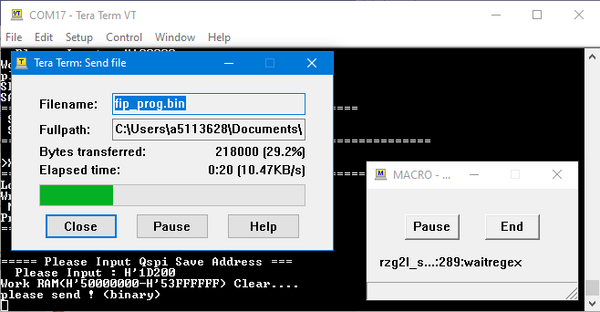RZ-G/RZ-G2L Flash Programming: Difference between revisions
| Line 89: | Line 89: | ||
* fip.bin | * fip.bin | ||
The file names may vary a bit. These are either the output of Yocto or generated by combining ATF and U-Boot binaries. Actually the first one is generated by ATF directly whereas the second is the generated by the [https://trustedfirmware-a.readthedocs.io/en/latest/getting_started/tools-build.html Firmware Image Package (FIP)] utility by combining BL3x binaries (BL31 secure monitor, BL32 OP-TEE and BL33 u-boot). | The file names may vary a bit. These are either the output of Yocto or generated by combining ATF and U-Boot binaries. Actually the first one is generated by ATF directly whereas the second is the generated by the [https://trustedfirmware-a.readthedocs.io/en/latest/getting_started/tools-build.html Firmware Image Package (FIP)] utility by combining BL3x binaries (BL31 secure monitor, optionally BL32 OP-TEE and BL33 u-boot). Note that u-boot used at this step is not the definitive one, its default environment parameters are adapted to allow the next steps to be executed automatically. The default environment parameters are configured in <code>include/configs/BOARD_NAME.h</code>, for example for the RZ/G2L smarc board: | ||
#define CONFIG_EXTRA_ENV_SETTINGS \ | |||
<code>"bootm_size=0x10000000 \0" \</code> | |||
<code>"baudrate=115200 \0" \</code> | |||
<code>"bootargs=rw rootwait earlycon root=/dev/ram0 rdinit=/home/root/my_init_flash_prog.sh \0" \</code> | |||
<code>"bootdelay=3 \0" \</code> | |||
<code>"bootimagerd=booti 0x40180000 0x49000000 0x40100000 \0" \</code> | |||
<code>"produsbbootargs=setenv bootargs rw rootwait earlycon root=/dev/ram0 rdinit=/home/root/my_init_flash_prog.sh \0" \</code> | |||
<code>"usbload=usb start;fatload usb 0 0x40180000 Image;fatload usb 0 0x40100000 r9a07g044l2-smarc-smarc-rzg2l.dtb;fatload usb 0 0x49000000 core-image-minimal-smarc-rzg2l-mod.cpio.gz.u-boot;run produsbbootargs \0"</code> | |||
<code>#define CONFIG_BOOTCOMMAND "run usbload;run bootimagerd"</code> | |||
These parameters ensure that: | |||
# After a boot delay of 3 seconds | |||
=== Linux script === | === Linux script === | ||
| Line 97: | Line 109: | ||
Usually dealing with this type of devices a Linux host PC is normally available. However sometimes it might be convenient to have a quick way to program the bootloaders using Windows. Especially during production, a Windows PC may be more convenient than a Linux PC. | Usually dealing with this type of devices a Linux host PC is normally available. However sometimes it might be convenient to have a quick way to program the bootloaders using Windows. Especially during production, a Windows PC may be more convenient than a Linux PC. | ||
Instead of using an ad-hoc tool developed only for the RZ/G2L the idea is to use a generic terminal utility. [https://ttssh2.osdn.jp/index.html.en Tera Term] is an open source tool that has some nice scripting capabilities embedded: a Tera Term script is called [https://ttssh2.osdn.jp/manual/4/en/macro/index.html MACRO]. The [https://github.com/seebe/rzg_stuff/blob/master/boards/rzg2l_smarc/rzg2l_smarc-rzg2l_flash_writer.ttl developed macro] "replaces" the user and provides inputs to Flash Writer, whose binary is also downloaded automatically. There are just a couple of parameters that you would need to change, stuff like COM port or the name of the Flash Writer binary to be used and whether the target is QSPI or eMMC. The "UNATTENDED" parameter suppresses all the user interaction apart from errors. | Instead of using an ad-hoc tool developed only for the RZ/G2L the idea is to use a generic terminal utility. [https://ttssh2.osdn.jp/index.html.en Tera Term] is an open source tool that has some nice scripting capabilities embedded: a Tera Term script is called [https://ttssh2.osdn.jp/manual/4/en/macro/index.html MACRO]. The [https://github.com/seebe/rzg_stuff/blob/master/boards/rzg2l_smarc/rzg2l_smarc-rzg2l_flash_writer.ttl developed macro] "replaces" the user and provides inputs to Flash Writer, whose binary is also downloaded automatically. There are just a couple of parameters that you would need to change (open the macro with a standard txt editor), stuff like COM port or the name of the Flash Writer binary to be used and whether the target is QSPI or eMMC. The "UNATTENDED" parameter suppresses all the user interaction apart from errors. | ||
It is assumed that MD_BOOTx pins are already configured for the final boot mode. However, if the target flash is virgin, the boot mode selected fails over to SCIF download, allowing the Flash Writer bin to be downloaded. | It is assumed that MD_BOOTx pins are already configured for the final boot mode. However, if the target flash is virgin / erased, the boot mode selected fails over to SCIF download, allowing the Flash Writer bin to be downloaded. | ||
[[File:TeraTerm macro.png|left|frameless|600x600px]] | |||
Revision as of 11:49, 7 March 2022
RZ/G2L boot modes are summarized in the table below.
| MD_BOOT2 to MD_BOOT0 | Boot Mode | Interface Module | Connected Device | ||
| 0 | 0 | 0 | Boot mode 0 | SDHI0 | eSD (3.3 V at startup) |
| 0 | 0 | 1 | Boot mode 1 | SDHI0 | 1.8-V eMMC |
| 0 | 1 | 0 | Boot mode 2 | SDHI0 | 3.3-V eMMC |
| 0 | 1 | 1 | Boot mode 3 | SPIBSC | 1.8-V Single Quad or Octal serial flash memory |
| 1 | 0 | 0 | Boot mode 4 | SPIBSC | 3.3-V Single or Quad serial flash memory |
| 1 | 0 | 1 | Boot mode 5 | SCIF0 | Downloading through SCIF |
In most of the Linux applications covered by the RZ/G2L, when it comes to non-volatile memory there are two main use cases:
- QSPI and eMMC. QSPI is normally used for firmware / boot loaders (i.e. ATF and u-boot) whereas eMMC for kernel and rootfs.
- eMMC only. In this case one of the two eMMC boot partitions is used for boot loaders and the user partition is then used for rootfs and kernel.
There might be other special cases but we can confidently state that these cover the great majority. We can also reasonably say that being the RZ/G2L a low-end device, there is the tendency to remove the QSPI to save money on the BOM.
At the end of the production line of course non-volatile memories are virgin (with a notable exception explained later) and need to be programmed. Usually firmware and bootloaders are relatively small (less than 1MB in total), kernel is instead in the tens of megabyte range and rootfs can go up to several hundreds of megabytes. To transfer this amount of data a fast interface is indeed required.
RZ/G2L cannot boot from USB, so at the end-of-line there are a few real viable options:
- Boot from SCIF (UART)
- Use JTAG
- It is worth to mention that, in general, if a QSPI FLASH is present on the custom board, it can also be bought preprogrammed
- Use a temporary QSPI flash card
- Booting from SD-card (TO BE CONFIRMED, specs officially allow eSD only)
In any of the cases above the goal is to have U-Boot up and running, then there are plenty of options to program the rootfs: ethernet, USB as host, USB with Mass Storage gadget, fastboot or even boot Linux kernel + initramfs.
With option 1, you can download Flash Writer and program the bootloaders, Arm Trusted Firmware (ATF) and U-Boot, into QSPI / eMMC boot partition, then reset and run U-Boot.
With option 2, you can download ATF and U-Boot via JTAG and then run the boot loaders without having to initially program them. Once U-Boot runs, you can program both bootloaders and rootfs.
With option 3, QSPI has already bootloaders pre-programmed, so U-Boot is already available.
With option 4, a QSPI flash card is somehow attached to the board that needs to be programmed. The QSPI flash contains ATF and U-Boot and potentially also the root file system to be programmed, depending on the size of both. More details are available here.
TO BE CONFIRMED. Option 5 may be complicated. Assuming the final goal is to boot from eMMC, since RZ/G2L can only boot from SDHI0, the system should implement a HW mechanism to switch from SD to eMMC during runtime.
All the options above may not require any human intervention and can be to a certain extent automatized.
In the rest of this page follow some examples on how to implement a fully atomized flash programming. More in particular we will focus on option 1, where ATF and U-Boot are programmed using the SCIF (Step 1). At the reboot U-Boot loads and boots kernel and the initramfs from USB. Then a custom init script is used of program the root file system stored on the USB thumb to the eMMC and eventually U-Boot is replaced, mainly to have a new set of environment variables to boot the final kernel / rootfs. It is assumed that all binaries to be programmed are already available, for example as result of the porting of the BSP.
Step 1 - Programming ATF and u-boot via SCIF
The main tool that can assist in performing external non-volatile memory (QSPI and eMMC) is Flash Writer. Depending on the host PC used, you can either use a bash script or a TeraTerm macro. In both cases you would need two files:
- bl2.bin
- fip.bin
The file names may vary a bit. These are either the output of Yocto or generated by combining ATF and U-Boot binaries. Actually the first one is generated by ATF directly whereas the second is the generated by the Firmware Image Package (FIP) utility by combining BL3x binaries (BL31 secure monitor, optionally BL32 OP-TEE and BL33 u-boot). Note that u-boot used at this step is not the definitive one, its default environment parameters are adapted to allow the next steps to be executed automatically. The default environment parameters are configured in include/configs/BOARD_NAME.h, for example for the RZ/G2L smarc board:
#define CONFIG_EXTRA_ENV_SETTINGS \"bootm_size=0x10000000 \0" \"baudrate=115200 \0" \"bootargs=rw rootwait earlycon root=/dev/ram0 rdinit=/home/root/my_init_flash_prog.sh \0" \"bootdelay=3 \0" \"bootimagerd=booti 0x40180000 0x49000000 0x40100000 \0" \"produsbbootargs=setenv bootargs rw rootwait earlycon root=/dev/ram0 rdinit=/home/root/my_init_flash_prog.sh \0" \"usbload=usb start;fatload usb 0 0x40180000 Image;fatload usb 0 0x40100000 r9a07g044l2-smarc-smarc-rzg2l.dtb;fatload usb 0 0x49000000 core-image-minimal-smarc-rzg2l-mod.cpio.gz.u-boot;run produsbbootargs \0"#define CONFIG_BOOTCOMMAND "run usbload;run bootimagerd"
These parameters ensure that:
- After a boot delay of 3 seconds
Linux script
A Linux bash script is available here. Please refer to the README for help on the usage.
Windows TeraTerm macro
Usually dealing with this type of devices a Linux host PC is normally available. However sometimes it might be convenient to have a quick way to program the bootloaders using Windows. Especially during production, a Windows PC may be more convenient than a Linux PC.
Instead of using an ad-hoc tool developed only for the RZ/G2L the idea is to use a generic terminal utility. Tera Term is an open source tool that has some nice scripting capabilities embedded: a Tera Term script is called MACRO. The developed macro "replaces" the user and provides inputs to Flash Writer, whose binary is also downloaded automatically. There are just a couple of parameters that you would need to change (open the macro with a standard txt editor), stuff like COM port or the name of the Flash Writer binary to be used and whether the target is QSPI or eMMC. The "UNATTENDED" parameter suppresses all the user interaction apart from errors.
It is assumed that MD_BOOTx pins are already configured for the final boot mode. However, if the target flash is virgin / erased, the boot mode selected fails over to SCIF download, allowing the Flash Writer bin to be downloaded.
Use JTAG
TBD


